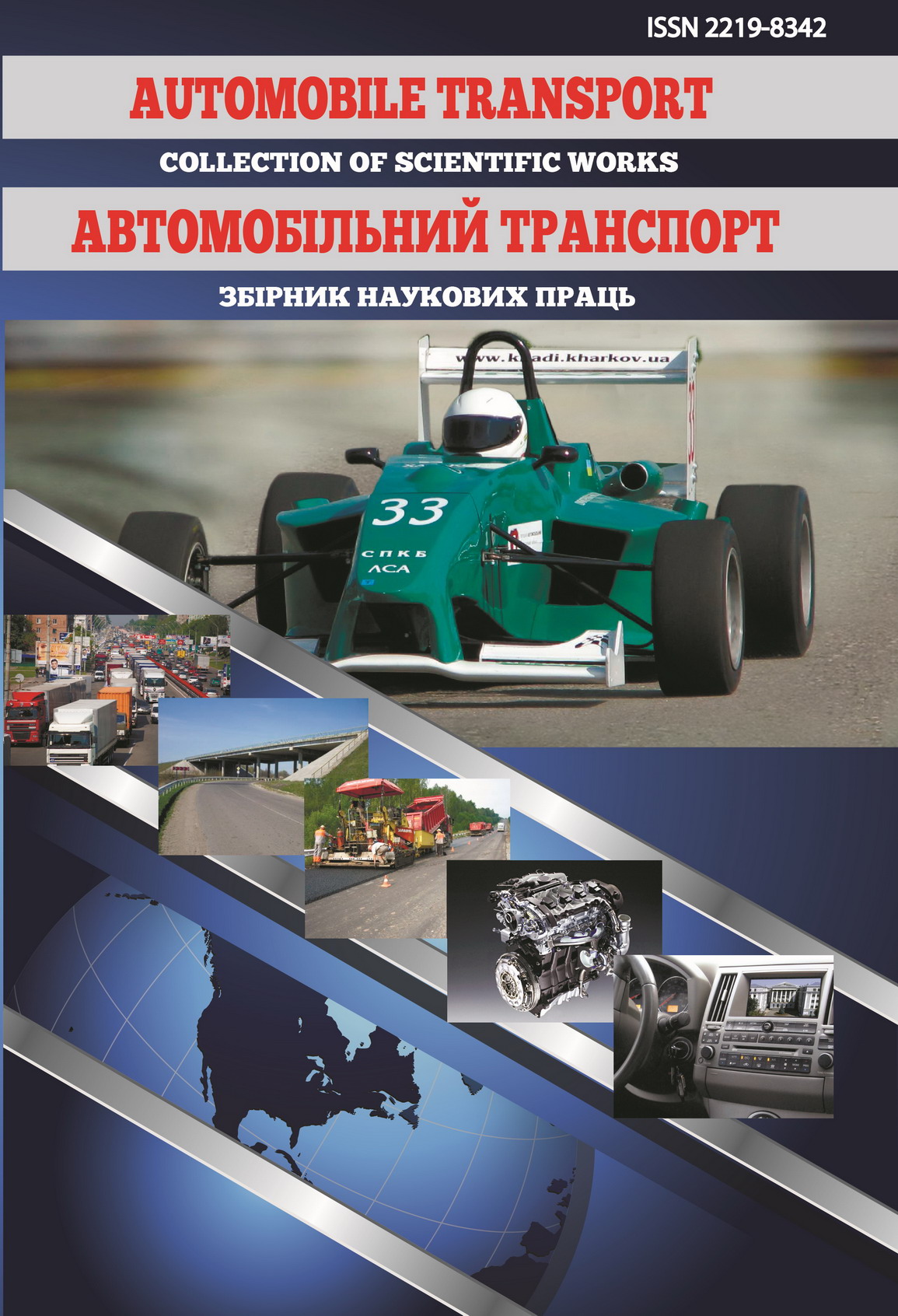ВПЛИВ ШИРИНИ ПРОЇЖДЖОЇ ЧАСТИНИ НА ШВИДКІСТЬ РУХУ АВТОМОБІЛІВ У МІСЬКИХ УМОВАХ
DOI:
https://doi.org/10.30977/AT.2219-8342.2019.44.0.50Ключові слова:
ширина дороги, швидкість автомобіля, міська вулиця, випадкова величина, гамма-розподілАнотація
Проблема. Швидкість автомобіля є найважливішим показником рівня організації дорожнього руху. Очевидно, що значення швидкості автомобіля в конкретному місці й у певний час є випадковим. Випадковість швидкості обумовлена впливом на неї занадто великої кількості чинників, що не можуть бути враховані аналітично, – від стилю водіння кожного водія, який сам по собі складається з індивідуальних, важко передбачуваних дій, до значного числа та індивідуальної поведінки інших учасників дорожнього руху. Установлення розподілу швидкості автомобіля в різних умовах є актуальним завданням, вирішення якого є основою для підвищення точності прогнозів руху, які формуються з використанням аналітичних або імітаційних моделей транспортних мереж та їх елементів. Мета. Отримання закономірностей зміни швидкості автомобіля в обмежених дорожніх умовах, з вузькою проїжджою дорогою. Методологія. Формування дійсної гіпотези щодо типу розподілу швидкості автомобіля в обмежених дорожніх умовах та її експериментальна перевірка на прикладі міської вулиці з припаркованими автомобілями. Результати. Гіпотеза про можливість використання гамма-розподілу для опису швидкості автомобіля в будь-яких умовах руху, тобто для будь-якої середньої швидкості автомобіля, не була спростована експериментальними спостереженнями руху транспортних засобів на вузькій ділянці міської вулиці завширшки 5,45 м для двох напрямків. Оригінальність. Запропонована та перевірена нова гіпотеза щодо розподілу швидкості автомобіля не у вільних, а в обмежених дорожніх умовах. Практична значущість. Отриманий результат дозволяє підвищити точність прогнозів руху з використанням аналітичних або імітаційних моделей транспортних мереж та їх елементів у транспортному консалтингу.Посилання
Managing Speed. Review of Current Practices for Setting and Enforcing Speed Limits. Transportation Research Board Special Report 254. National Research Council, Washington, D.C. – 1998 – 427 p.
Tefft B. C. Impact Speed and a Pedestrian’s Risk of Severe Injury or Death. AAA Foundation for Traffic Safety – 2011 – 17 p.
Taylor M. C., Lynam D. A. and Baruya A. The effects of drivers’ speed on the frequency of road accidents. TRL REPORT 421. Transport Research Laboratory, Crowthorne, England – 2000 – 56 p.
Berry D. S., Belmont D. M. Distribution of vehicle speeds and travel times. Proc. Second Berkeley Symp. on Math. Statist. and Prob. (Univ. of Calif. Press), – 1951 – pp. 589–602.
Patel C., Sharma J., Solanki J., Thakkar C., Prajapati N., Naik S. Spot speed study at A.V. road. International Journal of Advance Research and Innovative Ideas in Education. Vol-4 Issue-2 – 2018 – pp. 3207–3209.
Khan J. A., Tarry S. R. Speed spot study by comparing time mean speed and space mean speed: A case study. International Journal of Advanced Science and Research Volume 3; Issue 1; – 2018 – pp. 97–102.
Frith W. J., Patterson T. L. Speed variation, absolute speed and their contribution to safety, with special reference to the work of Solomon 2001 – 8 р.
Free speed survey 2011 (Urban and Rural). Research Department, Road Safety Authority, Ireland – 2012 – 50 p.
Down with Speed: A Review of the Literature, and the Impact of Speed on New Zealanders. Accident Compensation Corporation and Land Transport Safety Authority – 2000 – 81 p.
Murray D., Steven J. Empirical Analysis of Truck and Automobile Speeds on Rural Interstates: Impact of Posted Speed Limits. TRB 2010 Annual Meeting – 13 p.
Vadeby A. and Forsman A. Speed distribution and traffic safety measures. Transport Research Arena, Paris – 2014 – 10 p.
Garber N. J. and Hoel L. A. Traffic and Highway Engineering 4-th Edition. University of Virginia – 2009 – 1230 p.
Halder S., Islam A., Alam R.D. Traffic Speed Study Technical Report. Ahsanullah University of Science and Technology – September 2013 – 55 p.
Hunt P., Larocque B., Gienow W. Analysis of 110 km/hr Speed Limit: Implementation on Saskatchewan Divided Rural Highways. 2004 Annual Conference of the Transportation Association of Canada Québec City, Québec, 2004 – 20 p.
Minh C.C., Sano K., Matsumoto S. The speed, flow and headway analyses of motorcycle traffic. Journal of the Eastern Asia Society for Transportation
Studies, Vol. 6 – 2005 – pp. 1496 – 1508.
Y N.C., Minh C. C., Sano K., Matsumoto S. Motorcycle Equivalent Units at Road Segments under Mixed Traffic Flow in Urban Road. Proceedings of the Eastern Asia Society for Transportation Studies, Vol.7, 2009. – 14 p.
Dhamaniya A., Chandra S. Speed Characteristics of Mixed Traffic Flow on Urban Arterials. International Journal of Civil, Environmental, Structural, Construction and Architectural Engineering Vol:7, No:11 – 2013 pp. 883–888.
Rao A. M., Rao K. R. Free Speed Modeling for Urban Arterials – A Case Study on Delhi. Periodica Polytechnica Transportation Engineering 43(3) – 2015 – pp. 111–119.
Maurya A. K., Dey S., Das S. Speed and Time Headway Distribution under Mixed Traffic Condition. Indian Institute of Technology Guwahati, India – 2015 – 19 р.
Milton J., Mannering F. The Relationship Among Highway Geometries, Traffic-Related Elements and Motor-Vehicle Accident Frequencies. Transportation, Vol. 25; –1998 – pp. 395–413.
Sawalha Z., Sayed T. Evaluating Safety of Urban Arterial Roadways. Journal of Transportation Engineering. 2001; 127(2) – pp. 151–158.
Deller J. The influence of road design speed, posted speed limits and lane widths on speed selection— a literature synthesis. Australasian Transport Research Forum 2013 Proceedings 2 – 4 October 2013, Brisbane, Australia – 2013 – 14 p.
Zheng J., Sun J., Yang J. Relationship of Lane Width to Capacity for Urban Expressways. Transportation Research Record Journal of the Transportation Research Board 2483(2483) – 2015 – pp. 10–19.
Effects of Lane Width, Lane Position and Edge Shoulder Width on Driving Behavior in Underground Urban Expressways: A Driving Simulator Study. International Journal of Environmental Research and Public Health – 2016 – 14 p.
Horbachov P., Svichynskyi S. Theoretical substantiation of trip length distribution for homebased work trips in urban transit systems. Peter Horbachov, Stanislav Svichynskyi. The Journal of Transport and Land Use. – Center for Transportation Studies at the University of Minnesota, Vol. 11, No 1 (2018) – pp. 593–632.






